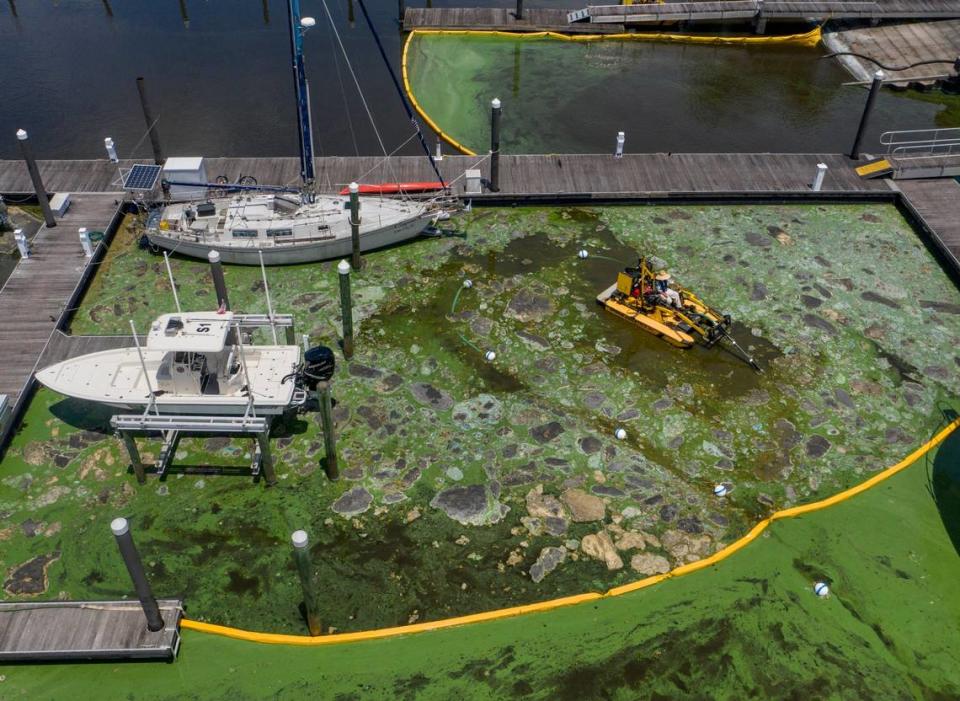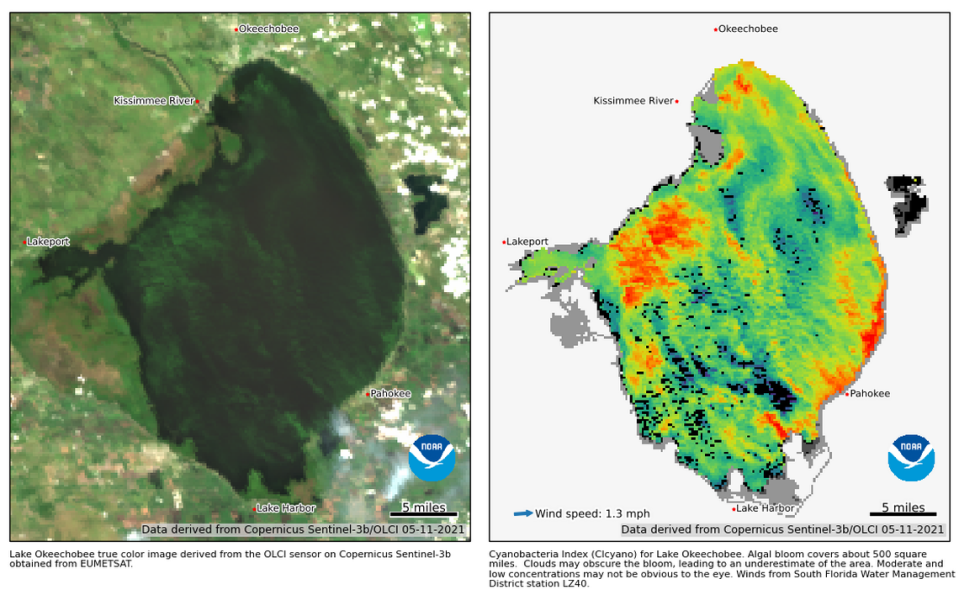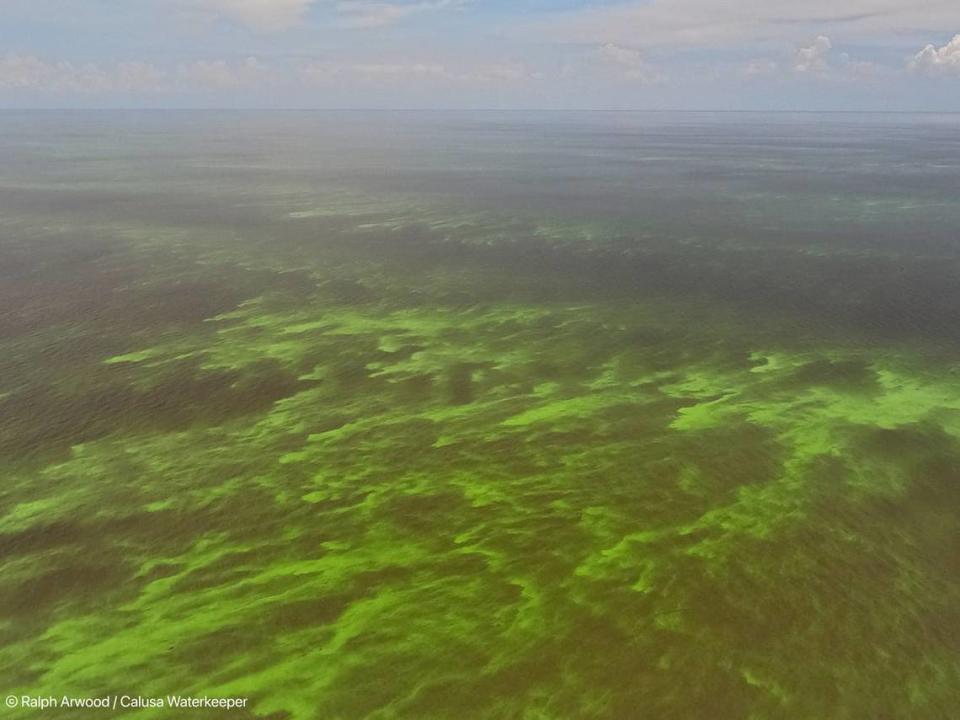‘Impending disaster.’ Worsening algae bloom on Lake Okeechobee threatens coasts again
The scene at Pahokee marina on Lake Okeechobee last week was a warning sign: A thick mat of algae in various shades of green, brown, gray and fluorescent blue covered the area around boat slips. In some spots, the gunk was so dense it stuck out two inches above the water.
Elsewhere on the lake, the algae wasn’t as chunky, but satellite photos were just as shocking: NOAA monitoring images on Wednesday showed nearly two-thirds of the lake, or 500 square miles, were covered with blue-green algae, the potentially toxic stuff that has fouled rivers and canals in the west and east coasts of Florida in past years, killing fish and scaring tourists away. Green streaks of algae are already visible moving down from the Moore Haven lock on the Caloosahatchee River, which has received Lake Okeechobee water releases in recent weeks to lower lake levels.
Is South Florida in for another summer of slime? The answer has a lot to do with how much water will be flushed from the lake to Florida’s west and east coasts. Already, Lake Okeechobee is at 13.6 feet, 2.5 feet higher than what it was at this time last year. Forecasters are predicting a “well above average” hurricane season this year.
“This is an impending disaster,” said John Cassani, of Calusa Waterkeeper. He and other activists are asking Gov. Ron DeSantis to declare a state of emergency to protect the Caloosahatchee from harmful lake discharges as the rainy season approaches and the need to lower water levels will be unavoidable. “Think of the lake as a giant cesspool being flushed into the Caloosahatchee every day with no end in sight. It’s a catastrophic situation.”

The bloom, which expanded quickly over the past few weeks as temperatures rose, is fueling heated debate about how the U.S. Army Corps of Engineers should manage lake waters considering conflicting interests: the need to send water south for Everglades restoration and the guarantee of sufficient supplies for farming while also managing flood protection structures such as its aging Herbert Hoover dike.
The Corps is currently revising its lake management policies to take into account a massive $1.8 billion upgrade of the dike that is scheduled to be completed next year as well as Everglades restoration projects that will come online in the next few years. The projects include a vast reservoir and stormwater treatment area that, once completed in 2023, will allow managers to send more water south when lake levels rise, reducing discharges to estuaries on the east and west. The aim is to produce water clean enough to replenish the Everglades amid efforts to recreate something close to the original flow of the River of Grass, going south through Shark Valley in Everglades National Park, taking much-needed fresh water all the way south to Florida Bay.
The Corps recently presented five conceptual plans for its new Lake Okeechobee System Operating Manual (LOSOM) that will receive public comment before more detailed proposals are presented in July.
But water quality activists want the state to act now under an emergency order to try to avoid a repeat of the devastating 2018 season when massive blooms of cyanobacteria in the lake were discharged to estuaries, killing marine life and making pets and even people sick. The blooms coincided with a widespread red tide that started in the Gulf Coast but spread as far as the Panhandle and St. Lucie County on the Atlantic coast, fouling beaches with dead fish and hundreds of marine animal carcasses.
On Friday the Corps said it will reduce discharges to the Caloosahatchee to 1,500 cubic feet per second from the current 2,000 cfs as a result of the blooms. Col. Andrew Kelly, the Corps commander for Florida, said releases will be made in pulses to try to flush out algae-laden freshwater and allow for water with higher salinity levels to move up the river.
“Some types of algae don’t do as well in higher salinity so we are trying to get some of the higher salinity up into the Caloosahatchee, which will support the degradation of some of that algae, by doing a pulse release of freshwater,” he said during a call with reporters.
Send ‘all that you can’ south
Friends of the Everglades, the Center for Biological Diversity, the Conservancy of South Florida and several water quality advocacy groups sent DeSantis a letter earlier this week saying the state must waive restrictions that stop water managers from moving more water south into conservation areas. Some of those restrictions exist to make sure the water is clean enough to go into conservation areas and beyond, into the Everglades.
DeSantis, who flew over Lake Okeechobee earlier this week to check on the problem, said he asked the District to send “all that you can south,” but didn’t respond to the request for an emergency order. He said he expects the Corps to come up with “a good regulation schedule that balances the equities” and mitigates negative impacts to coastal communities in the summer.

Treasure Coast Rep. Brian Mast threatened to sue the Corps to stop the discharges in an interview with CBS 12 on Thursday.
During a board meeting on Thursday, District staff said water conservation areas south of the lake were mostly full or couldn’t receive water because they were in the process of being restored or had projects under construction. Water Conservation Area 3, for instance, is undergoing restoration work after Tropical Storm Eta last year filled marshes to the brim, flooding tree islands and forcing deer to crowd onto levees to survive.
Communities around Lake Okeechobee said their needs must be taken into account. Hendry County Commissioner Ramon Iglesias expressed concern about a schedule that allows too much discretion and flexibility by the Corps every year. He said his fishing and farming community needs certainty so that residents can better plan their lives.
“No schedule should singularly prioritize the loudest people in the room,” Iglesias said during public comments. “We can have a schedule that takes everyone’s concerns into consideration, but not at the expense of my community or any other Floridian that depends on the lake when they need it for drinking, for fishing, for recreating, for farming and even for the environment.”
Sending water south to the Everglades during the dry season is common sense, but it’s important to hold the District accountable for how it manages water in the storm treatment areas, said Eve Samples from Friends of the Everglades. She said most of the water treated in these marsh-like reservoirs is runoff from farms and not water from the lake.
“Why is EAA farm runoff being given priority capacity in taxpayer-funded stormwater treatment areas when STAs could be cleaning water from the lake and sparing people east and west from exposure to these cyanotoxins?” Samples asked.
A decades-old fight for water
Organizations that defend agriculture said everyone is to blame. Nyla Pipes, a sugar industry advocate at One Florida Foundation, said nutrients come from multiple sources and all of them need to be addressed. She said people often blame agriculture because “the public really doesn’t understand that algae is already in our water” and it only gets out of control when there are too many nutrients.
“All this finger pointing ... we need to be looking in the mirror because it’s all of us,” she said.

The Everglades Foundation has said it’s about time the state started to manage the lake in a more equitable way and provided its own LOSOM idea to the Corps.
“Currently, we’re not managing Lake Okeechobee in a balanced way. It’s really managed for the needs of agriculture south of the lake, which is primarily sugar. They get the water when they want it. And when it rains, they dump all their stormwater into the Everglades,” said the foundation’s chief science officer, Stephen Davis.
The discussion highlighted the decades-old conflicts in lake water uses and needs. While higher levels benefit farmers that have for decades relied on consistently delivered lake water for their fields, environmentalists and coastal communities say the lake should be kept lower in the dry season and higher in the wet season, to prevent discharges of polluted water to the St. Lucie estuary in the east and the Caloosahatchee to the west.
To prevent a breach on the aging dike when there’s too much water in the lake, the Corps has historically discharged the excess to coastal estuaries. But Lake O is growing increasingly polluted with fertilizer from surrounding farms and communities, and decades of phosphorus and nitrogen that has accumulated on the bottom.
This “legacy pollution” can get stirred up by strong winds over the shallow lake, releasing nutrients that feed blooms. Davis said that’s probably the case now, as blooms are happening early in the season.
“Typically, we don’t see this much algal coverage on the lake until June or July, when we have the longest day lengths,” and sunlight drives the photosynthesis that makes algae grow and reproduce, he said.

 Yahoo Movies
Yahoo Movies 
